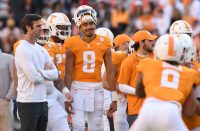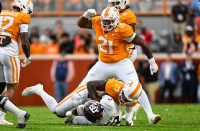In the off-season we do a series on Making Progress, on how the Vols can improve on the things they were very worst at in the previous year. Seven games into this season, Tennessee is moving in the right direction on most of those fronts:
- Running on third-and-short was the thing Tennessee was very worst at last season: 21 carries for 20 yards, the only team in college football to average less than 1.5 yards per carry (and the Vols averaged 0.95 yards per carry). It hasn’t gone from the basement to the penthouse, as you’d expect, but this year the Vols have 20 carries on 3rd-and-1-3 for 44 yards (2.20 ypc) and 13 first downs. Tennessee no longer has to go shotgun and hope for the best. (Stats via SportSource Analytics)
- Last year Tennessee ran fewer plays than any team in college football. This year the Vols are 116th of 130 in that department; they’re ahead of just five teams that have played seven games, and do have a handful of overtime snaps. Keep an eye on this number as the Vols enter a more winnable stretch of their season.
- Last season the Vols forced only 15 turnovers. Through seven games this year, Tennessee already has 13. Five against Chattanooga helped, but the Vols also had three against Florida and, more crucially, three against Mississippi State.
- In the massive improvement department: last year the Vols allowed opponents to score 41 times in 45 red zone visits, 120th nationally. So far this year opponents are just 25-of-32 (78.13%), 35th nationally. It’s bolstered by Chattanooga going 0-for-3 (which is still impressive), but the Vols also turned away Mississippi State once and intercepted Alabama.
- One area the Vols are yet to improve: explosive running plays. Last season Tennessee had 49 runs of 10+ yards, 116th nationally. Through seven games this season the Vols have 24 runs of 10+ yards, 115th nationally. Let’s see how that number improves when not facing Florida, Georgia, and Alabama.
Tennessee is better on a number of fronts, including the kind of significant improvement in turnovers and red zone defense that suggest a big difference on the scoreboard. What’s keeping that from happening?
Red zone offense.
In 24 red zone trips this season, Tennessee has only 10 touchdowns. That’s 41.67%, 124th nationally and one of just 16 teams scoring a touchdown less than 50% of the time they enter the red zone.
Here’s each of Tennessee’s 24 red zone possessions:
| Game | Qtr | Score | Result |
| Georgia State | 1 | 0-7 | TD |
| Georgia State | 2 | 14-14 | FG 19 yds |
| Georgia State | 4 | 20-21 | FG 31 yds |
| Georgia State | 4 | 23-38 | TD |
| BYU | 1 | 0-0 | TD |
| BYU | 2 | 7-3 | TOD 4th-&-1 |
| BYU | 4 | 13-10 | FG 22 yds |
| BYU | OT1 | 16-23 | TD |
| Chattanooga | 1 | 0-0 | TD |
| Chattanooga | 1 | 14-0 | TD |
| Chattanooga | 2 | 35-0 | FG 34 yds |
| Chattanooga | 3 | 38-0 | TD |
| Florida | 1 | 0-7 | INT |
| Florida | 3 | 0-17 | FG 40 yds |
| Georgia | 2 | 7-10 | TD |
| Georgia | 4 | 14-43 | TOD 4th-&-Goal |
| Mississippi St | 1 | 0-0 | INT |
| Mississippi St | 1 | 0-0 | TD |
| Mississippi St | 2 | 7-3 | INT |
| Mississippi St | 3 | 10-3 | FG 22 yds |
| Alabama | 1 | 0-7 | TD |
| Alabama | 2 | 7-14 | FG 37 yds |
| Alabama | 3 | 10-21 | FG 32 yds |
| Alabama | 4 | 13-28 | Fumble TD |
A word of praise is due Brent Cimaglia. Nine kickers with 7+ attempts have yet to miss a field goal this season. After those nine, no one has been better than Cimaglia’s 13-of-14 (92.9%). He made what were important kicks in the moment against Georgia State and BYU, gave Tennessee its first points at Florida, gave the Vols a two-possession lead against Mississippi State, and gave Tennessee a chance at Alabama. Perhaps we expect kickers to go 8-for-8 on attempts of 40 yards or less, but that’s usually not the exact result.
There’s enough bad to spread around on the red zone turnovers: Maurer’s two picks against Mississippi State, a ball Jauan Jennings should’ve caught at Florida, and Guarantano’s poor choice on Saturday night. Whatever it’s worth, JG also failed to get the backups in on four tries from the five yard line against Georgia’s backups. And Eric Gray was stuffed on an important early sequence against BYU, foreshadowing the end-around stop just outside the red zone later in the game.
Tennessee’s struggles at the doorstep have been particularly painful. At the end of the first half against Georgia State the Vols had two shots from the three yard line but couldn’t get in. Early in the fourth quarter the Vols had 3rd-and-2 at the Georgia State 14, but a pass to Austin Pope went for no gain and the Vols settled for three to take a 23-21 lead. Aside from the fourth down stops, against BYU the Vols also had 1st-and-Goal at the 9 early in the fourth quarter with a chance to take a two-possession lead up 13-10, but had to kick a field goal.
The interception at Florida was obviously painful, but with only two red zone visits I’m not sure Tennessee is winning that game either way. But what happened at Alabama was a microcosm of this problem before the Guarantano fumble. On the drive when Maurer was injured, the Vols had 1st-and-Goal at the 5 and went false start, no gain, holding, incomplete, then Guarantano missed Jennings on the double move. The other sequence was more about officiating, when 1st-and-Goal at the 7 led to a phantom holding penalty and then a missed pass interference call. But against Alabama, the Vols were so close to doing something really special on three separate drives, then went field goal, field goal, disaster.
So here’s some good news: on drives Brian Maurer finished, you do of course have a pair of end zone interceptions against Mississippi State, which we’re chalking up to some combination of freshman mistakes and a concussion. But the other red zone trips led by Maurer: a touchdown to open the third quarter against Chattanooga, the only points of the day at Florida (on a drive that reached only the 20), an A+ touchdown throw against Georgia, Tim Jordan’s touchdown run against Mississippi State, and a QB sneak touchdown at Alabama. In Maurer’s seven red zone drives, the Vols have four touchdowns, the field goal at Florida, and the two picks against Mississippi State. Obviously, you can’t throw picks in the end zone. But the other results have been good, including that throw against Georgia which is the best individual play Tennessee has made in the red zone this season and perhaps beyond. It’s a small sample size: Maurer is 1-of-6 in the red zone this year, the one being that touchdown, with two of the five incompletions being those interceptions. But Guarantano is 9-of-24 for 79 yards with five touchdowns and the interception at Florida. Those five touchdowns include the last-second TD against Georgia State, the batted-ball against BYU, the overtime TD catch by Jennings, and two scores against Chattanooga. When the windows get tight, everyone has struggled. Guarantano was better here last year too: 14-of-23 for 111 yards in the red zone, with seven touchdowns and, importantly, zero interceptions.
Everything is on the table, but if you’re going to expect anything in these next five games, I’d lean toward close calls. That means all of these red zone trips are going to count. And the Vols, who traded a chance for something special into Alabama’s spectacular last week, have to put the ball in the end zone more often. If Maurer comes back, can he continue this trend? If it’s Shrout, can he learn on the fly? And if it’s Guarantano, can he recover from everything he’s faced this season and get this team in the end zone?




It’s obviously hard to play the “what if” game because the butterfly effect may mean the game unfolds completely differently.
But the Vols left 4 points on the field on that first FG drive (before missing Jennings, don’t forget that 1st and goal at the 5 where the Vols went wildcat with Bama confused before a random ref stoppage for…reasons), 4 points on a questionable holding call on the next FG drive, and then a 14-point swing on the 4th and goal.
4+4+14 = 22. The Vols lost by…22 points.
Yeah, nothing about Tennessee’s performance was a fluke there, other than maybe Tua trying to make a play no QB alive could’ve made on their INT. We should be done being +30 to anyone.